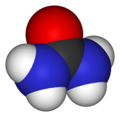Urea
Urea is an organic compound. It was first found in urine in 1773 by the French chemist Jean Rouelle. It is also called Carbamide, and its chemical names are Carbonyl Diamide (used in inorganic chemistry) and Diaminomethanal (used in organic chemistry).
| Urea | |
|---|---|
| IUPAC name | Aminomethylamide |
| Other names | Carbamide |
| Identifiers | |
| CAS number | |
| SMILES | NC(=O)N |
| Properties | |
| Molecular formula | (NH2)2CO |
| Molar mass | 60.07 g/mol |
| Appearance | white odourless solid |
| Density | 1.33·10³ kg/m³,[1] solid |
| Melting point |
132.7 °C (406 K) |
| Boiling point | |
| Solubility in water | 108 g/100 ml (20 °C) 167 g/100 ml (40 °C) 251 g/100 ml (60 °C) 400 g/100 ml (80 °C) 733 g/100 ml (100 °C) |
| Acidity (pKa) | 0.18 |
| Basicity (pKb) | 13.82 |
| Structure | |
| Dipole moment | 4.56 p/D |
| Hazards | |
| MSDS | ScienceLab.com |
| NFPA 704 |
|
| Except where noted otherwise, data are given for materials in their standard state (at 25 °C, 100 kPa) | |
In humans, it is a normal component of blood and many body tissues. It is produced in the liver, where ammonia, a very toxic substance, is changed into urea, which has a very low toxicity, so low in fact, that it is many times less toxic than table salt. Most of the urea produced in this way is not needed by the body, and is removed from the blood in the kidneys and taken out of the body in urine.
Urea Media
A plant in Bangladesh that produces urea fertilizer.
References
Other websites
- MSDS sheet on urea Archived 2011-05-15 at the Wayback Machine
- Use of urea in hand dyeing
- use of urea as an automotive reagent to reduce harmful emissions (AdBlue)
- The dispensing and handling of Urea AdBlue (AdBlue Archived 2016-06-30 at the Wayback Machine)





